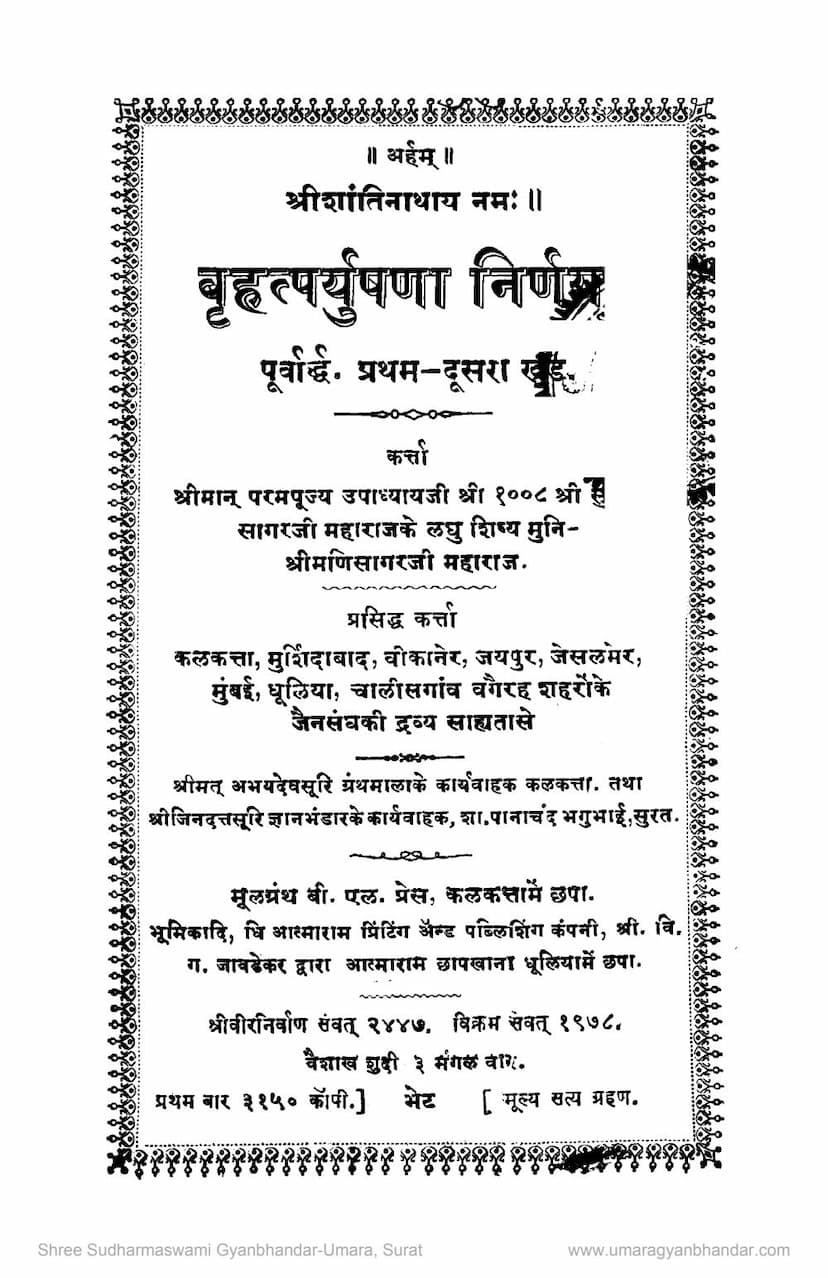Bruhat Paryushana Nirnay
Added to library: September 1, 2025

Summary
Here's a comprehensive summary of the provided Jain text, "Bruhat Paryushana Nirnay," based on the pages you've shared:
Book Title: Bruhat Paryushana Nirnay Author: Muni Manisagar Publisher: Jain Sangh Catalog Link: https://jainqq.org/explore/034484/1
Overall Purpose:
The "Bruhat Paryushana Nirnay" by Muni Manisagar is a comprehensive text aimed at clarifying and resolving disputes within the Jain community, particularly concerning the observance of the Paryushana festival and related rituals. The author, Muni Manisagar, expresses a strong desire to unite the Jain community by focusing on the core principles of Jainism as dictated by the Jinagama (Jain scriptures) rather than rigid adherence to sectarian traditions or dogmas. He aims to provide scriptural evidence and logical reasoning to dispel doubts and promote the correct understanding and practice of Jain principles, emphasizing purity of faith (Shraddha) and righteous conduct (Kriya) for spiritual upliftment.
Key Themes and Arguments:
The text, particularly in its introductory sections (Pages 2-10), addresses several critical issues and concerns prevalent in the Jain community at the time of its writing:
-
Beyond Sectarianism (Gachha Unity): The author strongly advocates for transcending narrow sectarian loyalties (Gachha differences). He argues that true liberation lies not in adhering to the traditions of a particular Gachha but in practicing pure religious actions according to the Jinas (Tirthankaras) command. He urges followers to examine their traditions based on Jinagama and embrace the truth, irrespective of its origin. He emphasizes that unity and mutual respect among different Gachhas are crucial for spiritual progress, discouraging disputes, criticism, envy, and conflict.
-
The Authority of Jinagama: The text upholds the absolute authority of the Jain scriptures (Jinagama) as the unerring word of the omniscient Tirthankaras. It stresses that all scriptures, including Panchangi, Prakaran, and Charitra, should be accepted as valid. However, it cautions against superficial understanding, urging readers to grasp the deep meanings, underlying principles, and contextual nuances of scriptural passages, acknowledging that different interpretations may arise from varying perspectives (Nishchaya, Vyavahar, etc.).
-
Addressing Controversies: A significant portion of the introductory text is dedicated to addressing and resolving specific points of contention:
- Paryushana Timing: The text elaborates extensively on the correct timing of the Paryushana festival, particularly in relation to intercalary months (Adhik Maas). It meticulously references ancient scriptures like Nishi.th Chu rni, Brihat Kalpa Chu rni, Paryushanakalpa Niyukti, and Samavaya Sutta Vritti to establish that Paryushana should be observed 50 days after Ashadh Chaturmas, regardless of an intercalary month. It refutes the practice of delaying Paryushana by 80 days (e.g., in the second Bhadrapad) when an intercalary month occurs, citing scriptural evidence and historical practices of various Gachhas.
- The Six Kalyanaks (Auspicious Events): The author strongly defends the scriptural basis for recognizing six auspicious events (Kalyanaks) in the lives of Tirthankaras, including the second conception (Garbha-samkraman) as a significant 'Chyavan' (descent) event. He refutes the idea that these are merely 'objects' or 'stages' and not auspicious events, emphasizing that the terminology may vary but the essence and scriptural support remain valid. He addresses specific interpretations regarding Lord Mahavir's Kalyanaks, citing scriptural passages and the observances of various Gachhas to support the recognition of the second conception as a valid Chyavan Kalyanaka.
- Samayika Rituals: The text clarifies the correct procedure for Samayika (a Jain ritual), emphasizing that the "Karemi Bhante" (a specific invocation) should be recited first, followed by the "Eriyavahi" (a ritual of self-purification and mindfulness). It criticizes certain practices that deviate from this order, citing scriptural contradictions that arise from misinterpretations.
-
Correction of Misconceptions and Debates: Muni Manisagar identifies specific individuals and their works (like Subodhika, Deepika, Kiralavali) that he believes have propagated incorrect interpretations or introduced unnecessary disputes. He aims to provide a scripturally sound resolution to these debates, not to create new conflicts but to guide sincere seekers of truth.
-
Importance of Pure Faith (Samyaktva): The author repeatedly emphasizes that true spiritual progress is contingent upon pure faith (Samyaktva). He states that even extensive ritualistic observances without correct faith are ineffective for spiritual liberation. He encourages readers to study, contemplate, and internalize the teachings presented in the book to attain true faith and engage in self-purification.
-
Role of Gurus and Traditions: While advocating for scriptural adherence, the author also acknowledges the importance of Guru parampara and established traditions. However, he stresses that these should align with Jinagama, and blind adherence to tradition without scriptural validation is discouraged.
-
Call for Unity and Understanding: The overarching message is one of unity, understanding, and adherence to truth as per the Jinagama. The author hopes that by presenting a clear and scripturally supported exposition, he can help the Jain community overcome disputes and focus on their spiritual welfare.
Structure of the Text (based on the provided pages):
- Page 1: Title page, author, publisher, catalog link, and publication details (V.S. 1978/V.N. 2447, 3150 copies).
- Pages 2-10: This section comprises the "Introduction" or "Bhumika" (Preface/Foreword). It lays out the author's purpose, his approach to resolving disputes, the importance of scriptural authority, the need to transcend Gachha differences, and addresses specific controversial points like the timing of Paryushana and the interpretation of Kalyanaks. It also mentions the author's intention to resolve doubts raised by Muni Mahashayas reading other commentaries.
- Pages 11 onwards: This section begins to delve into the detailed explanations and scriptural arguments related to Paryushana, the six Kalyanaks, and other relevant practices. It references numerous Jain scriptures and commentaries to support its claims.
Summary in Essence:
Muni Manisagar's "Bruhat Paryushana Nirnay" serves as a scholarly and devotional effort to clarify Jain practices, particularly the Paryushana festival, by grounding them firmly in the Jinagama. It advocates for unity, correct faith, and the understanding of scriptures over blind adherence to sectarian traditions. The book addresses historical debates, offering scriptural resolution and emphasizing that true spiritual progress comes from righteous action aligned with pure faith. The author's dedication to resolving disputes and fostering understanding within the Jain community is evident throughout the text.